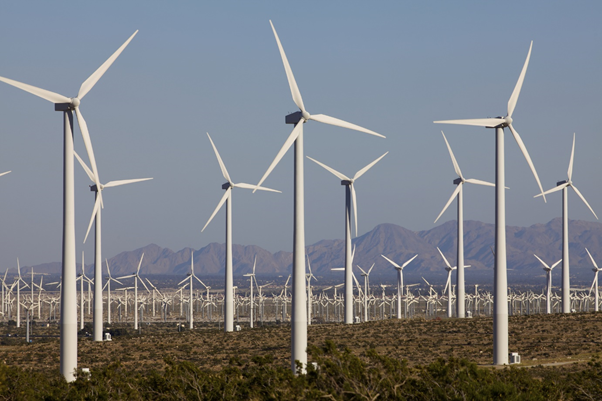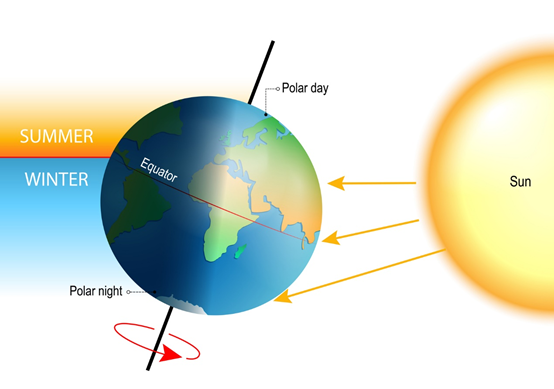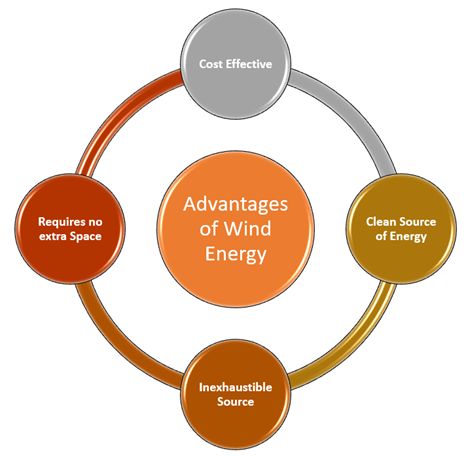Definition
Related Definitions
Wind Energy
What is Wind Energy?

Source: © Sbures | Megapixl.com
Wind energy is a form of a renewable and green source of energy. Wind turbines are used to convert wind energy to electrical energy. It is a sustainable form of energy that can uninterruptedly supply energy. Wind turbines are equipped with blades that rotate after coming in contact with flowing wind. The rotation of blades triggers the gearbox linked with the main shaft of the wind turbine. The energy from the gearbox is sent to the mechanical generator, which converts it into electrical energy. The generated electrical energy can be directly used or can be stored with the help of batteries for later usage.
What are Wind Turbines?
Wind turbines are mechanical devices that are used to convert wind energy into electrical energy. A typical wind turbine looks like a windmill. The turbines are fitted in high rise towers, ranging to a height of approximately 30 meters so that they can capture most of the wind's energy. Usually, two or three propellers are attached to the turbine to capture the wind energy and rotate after receiving it.
As the wind blows, a low-pressure air pocket forms at the downwind side of the blade, the low-pressure zone tries to pull the blade towards it to balance the pressure difference, and as a result, the blades start moving, and the rotor turns. This process is known as lift. The lift force is much stronger than the drag force that applies at the front side of the blade. The combination of drag and lift forces spins the rotor like a propeller, and in turn, the generator produces electricity.
Why does the wind blow?
The atmosphere is made up of a different type of gases which are mixed together. The volume of these gases increases as their temperature increases because the molecules gain more energy and become excited; thus, they move further apart. On the flip side, when the temperature goes down, the molecules of gas become dense and acquire less space.

Source: © Designua | Megapixl.com
The uneven distribution of the Sun's energy over the earth due to the difference in angle of incidence energy creates temperature variation. The inclination and shape of the earth also contribute to the uneven distribution of the Sun's energy over the earth's surface.
Since gases behave differently at different temperatures, the areas receiving higher Sun's energy get heated up, increasing the air temperature. The rise in air temperature ultimately increases the pressure and volume of air forcing it to rise, leaving a low-pressure pocket behind it.
As soon as the local pressure of an area drops, to balance the pressure difference, air flows from higher pressure areas to these low-pressure pocket zones. This process is known as diffusion, and it is the only cause of air or wind to blow.
What are the best places for the installation of a Wind Turbine?
Coastal areas are the best places for the installation of wind turbines. Usually, an open place with strong wind flow is preferred for the installation of wind turbines. Hilltops and mountain gaps with good airflow can also be used for the installation. One needs an uninterrupted average wind speed of 25km/h for the turbines to work effectively. Most of the wind farms in the UK are located in Wales or Cornwall. In California, wind turbines supply electricity to areas located in the vicinity of Los Angeles.
The turbines are usually not installed in crowded and residential places as they produce a significant amount of noise, making it difficult for people to reside in the nearby areas. They are also not installed in places where frequent birds are seen because the blades can kill them unintentionally.
Summary
- Wind energy is a form of renewable and green energy that can provide an uninterrupted supply if installed in the proper place.
- Wind turbines are equipped with blades that rotate after coming in contact with flowing wind, and this mechanical energy is converted into electrical energy with the help of generators.
- Installation of wind turbines requires an average wind speed of 25km/h, and coastal areas are the best places for their installation.
Frequently Asked Questions (FAQs):
What are the advantages of Wind Energy?
There are various advantages of wind energy. Let us discuss the most important advantages one by one:

Copyright © 2021 Kalkine Media Pty Ltd
- Cost-Effective: Wind energy is the cost-effective energy source, which is considered the lowest-priced energy source today. It costs around US$0.01 to US$0.02 per kWh.
- Clean Source: Wind energy offers a clean source of energy that is carbon-free and doesn't generate any form of greenhouse gases. Wind energy has the potential to replace a significant portion of fossil fuel usage, which are responsible for creating a huge amount of carbon emissions.
- Inexhaustible Source: Wind energy is an inexhaustible source of energy that is never-ending. It has the capability of supplying an uninterrupted flow. In the last decade, the US's wind energy share has grown at the rate of 15 per cent annually.
- Requires no extra Space: The installation of wind farms can be done on pre-existing farmlands and ranches. It doesn't require additional space as the installation of turbines takes up only a small area which doesn't affect the ongoing activity on the land.
What are the disadvantages of Wind Energy?
Wind energy has a lot of advantages, but it doesn't mean that it doesn't have any drawbacks. Let us glance at the most significant drawbacks of wind energy:
- Challenging cost: Despite the numerous technological advancements in the past few years, the cost associated with the electricity generation in a wind farm or turbine is much higher than generating energy from conventional methods.
- Noise Pollution: The turbines installed for the generation of electrical energy create noise pollution, which may harm the environment.
- Impact on local Wildlife: The installation of wind farms can affect the local wildlife significantly. Spinning turbines may kill flying birds, and farms can disturb the local habitat of animals.
- Transmission Cost: Usually, wind farms are located in remote areas, away from cities where the electricity requirement is almost nil. So, an additional cost for installation of a transmission line can increase the investment, reducing cost-effectiveness.
